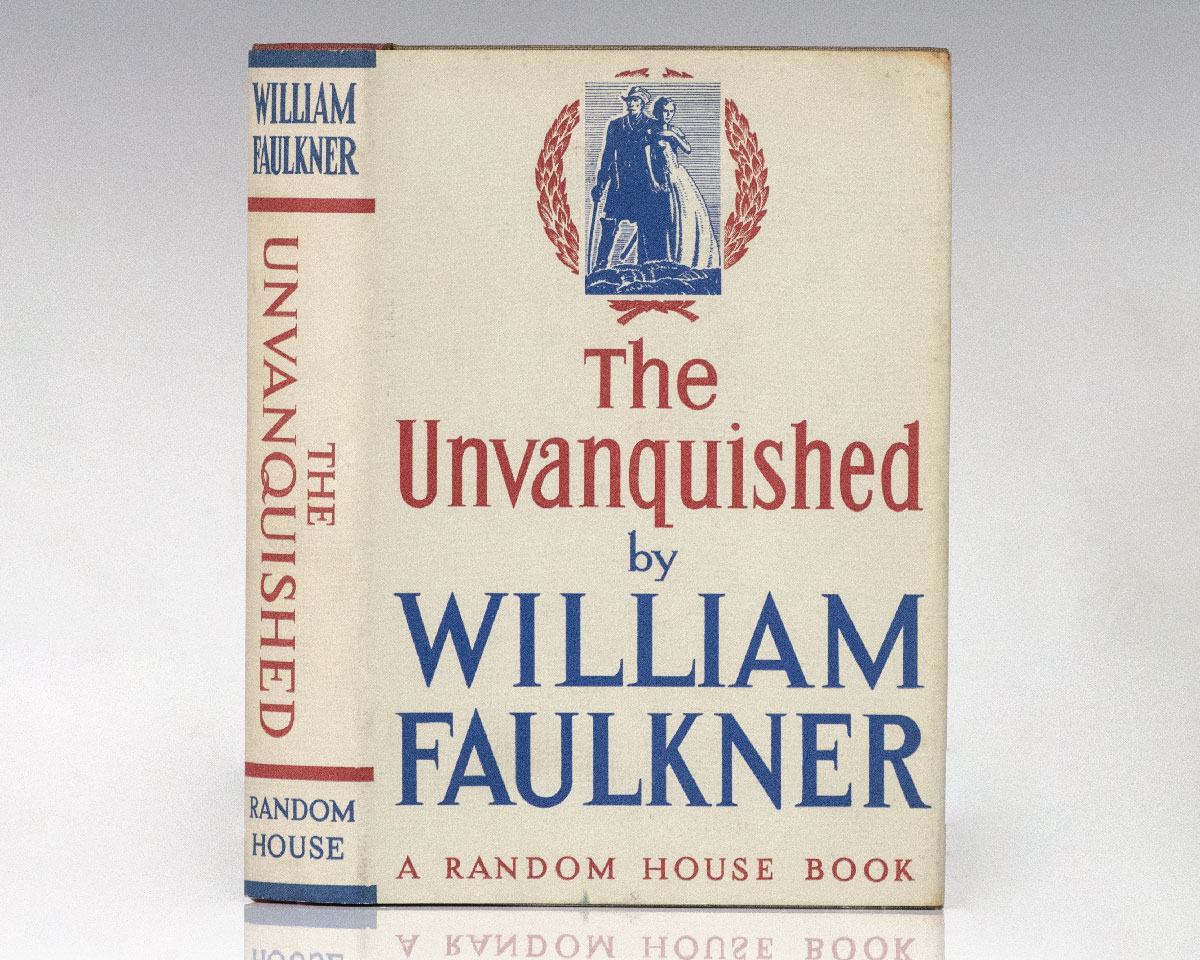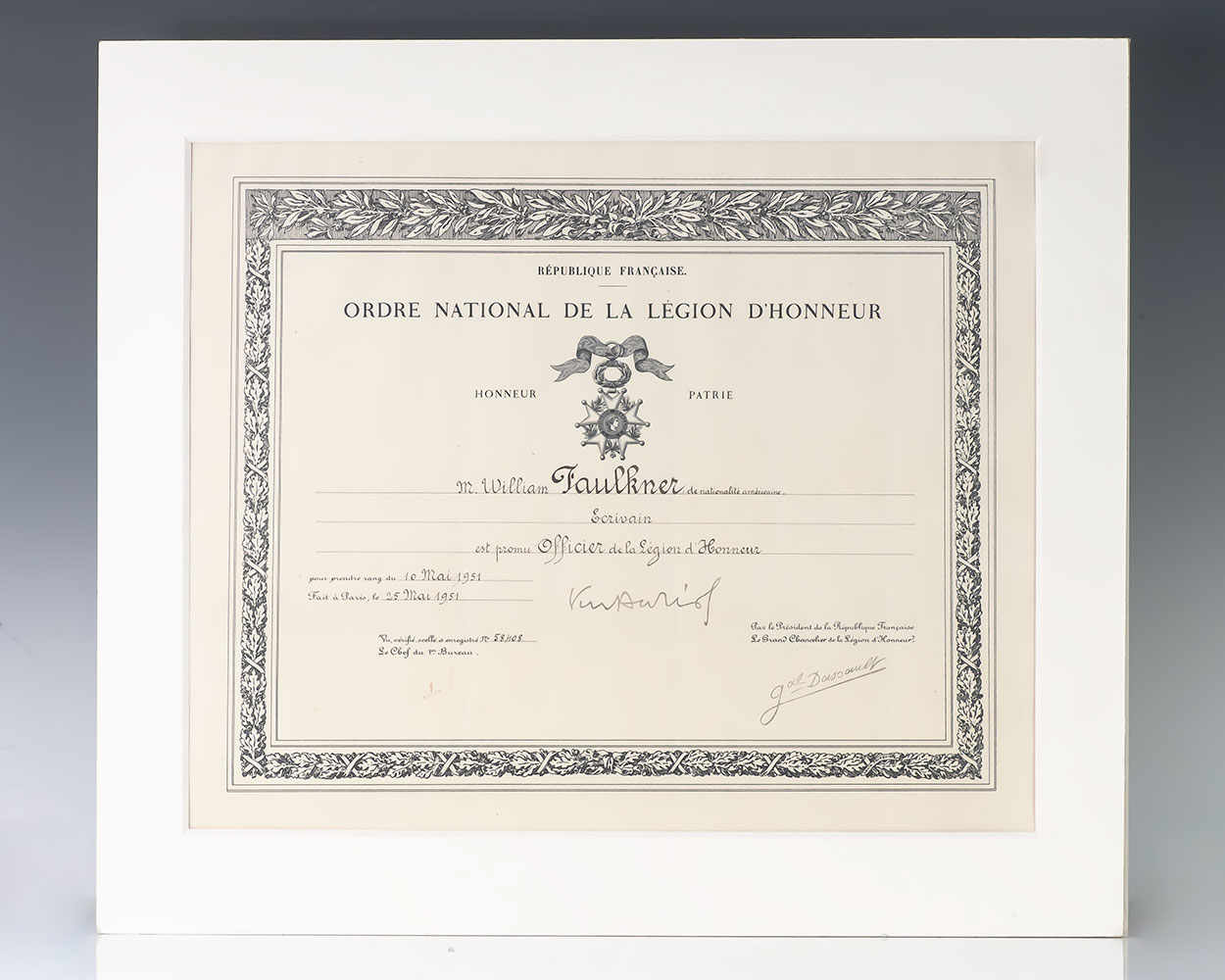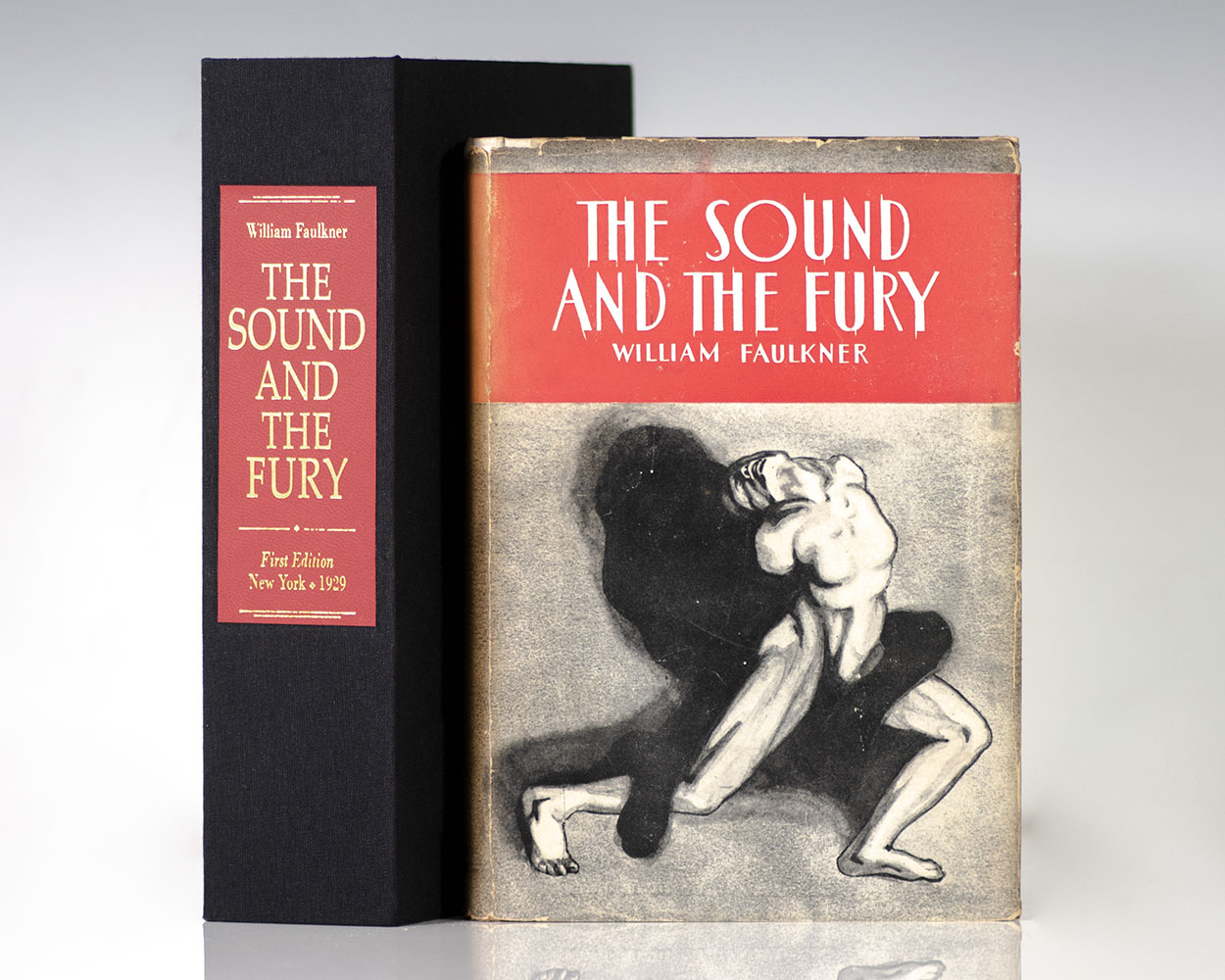Shop
-
First Edition of William Faulkner's The Town
FAULKNER, WILLIAM.
The Town.
New York: Random House 1957.
First edition, first printing of the second novel in Faulkner’s celebrated Snopes trilogy with line 8 on page 327 repeated as line 10. Octavo, original cloth. Near fine in a very good later issue dust jacket. Bookplate to the front free endpaper and ownership inscription to the pastedown. Jacket design by Push Pin Studios.
Price: $150.00 Item Number: 140009
-
"A Faulkner oddity with a most interesting genesis and publication history": Three original typed drafts of William Faulkner's short story Afternoon of a Cow. By Ernest V. Trueblood
FAULKNER, WILLIAM.
Afternoon of a Cow Original Typed Manuscript Drafts.
: .
Three original typed drafts of William Faulkner’s parodical short story “Afternoon of a Cow. By Ernest V. Trueblood.” Two complete copies, each 17 leaves; bound with brass clasps in green folders with the third copy lacking the first leaf; with 49 strikethroughs in Faulkner’s hand throughout most excising a single word. When Faulkner returned to Oxford at the end of World War I, he was writing poetry, much of it under the influence of the French Symbolists. In the summer of 1919, he borrowed Mallarmé’s title, “L’Après-midi d’un Faune,” for a 40-line poem of frustrated love. The poem appeared in The New Republicon 16 August was a revised version appeared in The Mississippian at Ole Miss in the fall. Early the next year he was to publish in Oxford a poem inviting comparison with François Villon, “Une Ballade des Femmes Perdues.” As Joseph Blotner says diplomatically, “Such poetry unsurprisingly provoked various responses.” Parodies began to appear in The Mississippian. One was “Une Ballade d’une Vache Perdue,” signed by “Lordgreyson.” The poem described the heifer Betsey, lost and wandering far from home. “It was an amusing tour de force, which Faulkner may have had in mind seventeen years later, ‘one afternoon,’ he recalled, ‘when I felt rotten with a terrible hangover.’ He was then working unhappily at Twentieth Century-Fox” (Blotner). “The story generates interest because it uses Faulkner himself as a character, much in the manner of a post-modernist writer such as Paul Auster. The story reports on a frightened cow that has fallen into a ditch during a fire. The character Faulkner, along with Oliver, a black butler, and Ernest V. Trueblood, the first-person narrator of the tale, rush to rescue the cow, but they are at first unsuccessful. In its fear and distress, the cow empties its bladder and bowels upon Faulkner, shattering the dignity of the scene. The story ends with Faulkner stripping in the door of the stable and washing. Latter, wrapped in a horse blanket, he and his friends drink to the cow” (Fargnoli & Golay). Faulkner was very fond of this story and thought it particularly funny. On 25 June 1937, he read the story to his guests after dinner in Los Angeles, telling them it was the work of a talented boy named Ernest V. Trueblood. The only person who seemed to appreciate the story was his house guest and French translator, Maurice Coindreau. The Frenchman was in Los Angeles to discuss his translation of The Sound and the Fury, which became one of the most influential and celebrated literary translations of the century. Faulkner gave Coindreau a carbon typescript of the translation as a souvenir. In 1939, Faulkner was to appropriate elements of the story for the mock chivalric romantic treatment of Ike Snopes’s love for Jack Houston’s cow in The Hamlet. During the war, Faulkner approved Coindreau’s translation of the story, published in the June/July number of Fontaine in Algiers. It first appeared in English in Furiosoin 1947 and was anthologized by Dwight Macdonald in a collection of parodies in 1950. In very good condition.
Price: $15,000.00 Item Number: 139485
-
"What threatens us today is fear": The original typed manuscript of Faulkner's important public address to his daughter Jill's graduating class at University High School in Oxford Mississippi; with autograph corrections and deletions in his hand
FAULKNER, WILLIAM.
Address to the Graduating Class of 1951 of University High School, Oxford, Mississippi.
: .
The original typed manuscript of Faulkner’s important public address to his daughter Jill’s graduating class at University High School in Oxford Mississippi with autograph corrections and deletions in his hand. Three pages, carbon typescript, the text contains 8 strikethroughs and 6 autograph corrections in Faulkner’s hand in ink. In this important public address, Faulkner clarifies for a young audience the terms for survival and optimism in the Cold War era, ideas which he first expressed publicly five months earlier in his Nobel Prize acceptance speech. In the spring of 1951, Faulkner was in Paris, New York, and Lexington, Kentucky, where he covered the Kentucky Derby for Sports Illustrated. He had planned to return to Oxford and resume work on Requiem for a Nun; however, “Jill had telephoned him in New York to say that the principal of the high school had asked if he would talk to her high-school class. It sounded like some sort of informal talk, and he found it difficult to refuse Jill anything within reason. On arriving home, he found that it was the featured address at the commencement ceremonies for her graduating class. He would have to write another speech, for a formal event before more than a thousand people” (Blotner). In addressing the graduating seniors and their families, Faulkner begins with the threat of the atomic bomb and informs his audience that there are more sinister forces then even the bomb at work in the post-war world. As early as 1945, he had expressed in private letters his distaste for communism and the Soviet Union. He chose not to name these threats to individuality and personal freedom in his Nobel speech. Here, by contrast, he zeroes in on his target: “Our danger is the forces in the world today which are trying to use man’s fear to rob him of his individuality, his soul, trying to reduce him to an unthinking mass by fear and bribery—giving him free food which he has not earned, easy and valueless money which he has not worked for; — the economies or ideologies or political systems, communist, or socialist or democratic… whatever they wish to call themselves, who would reduce man to one obedient mass for their own aggrandizement and power, or because they themselves are baffled and afraid, afraid of, or incapable of, believing in man’s capacity for courage and endurance and sacrifice.” The typescript reads: “man’s capacity for courage and honor and compassion and sacrifice.” Toughening his stance and reinforcing his tempered pessimism, he scores through “honor and compassion,” replacing them with “endurance” in ink. After exhorting the students to retain their individuality, and thus change life on earth, he ends by telling them: “In one generation all the Napoleons and Hitlers, Caesars and Mussolinis and Stalins and all the other tyrants who want power and aggrandizement, and the simple politicians and time-servers who themselves are merely baffled or ignorant or afraid, who have used, or are using, or hope to use, man’s fear and greed for man’s enslavement, will have vanished from the face of it.” As in Stockholm, Faulkner spoke softly and rapidly and many in the audience could not understand his words, despite the fact that a he was using a public-address system. It was the largest graduation audience Oxford had ever seen and the applause was thunderous. At four and a half minutes, it was also the shortest graduation address on record. In near fine condition. This major public address, often overshadowed by the Nobel Prize acceptance speech, shows William Faulkner as vigilant Cold Warrior, distinguished citizen of Oxford and proud parent of a graduating high school senior.
Price: $17,500.00 Item Number: 135874
-
Original typed manuscript of an untitled short story by William Faulkner's father, Murry Cuthbert Falkner
FALKNER, MURRY CUTHBERT. [WILLIAM FAULKNER].
Murry Cuthbert Falkner Typed Short Story Manuscript.
: .
Original typed manuscript of an untitled short story by William Faulkner’s father, Murry Cuthbert Falkner [William changed the spelling of his surname from Falkner to Faulkner early in his writing career], preserved among the family’s papers and only recently discovered. Quarto, carbon typescript, 13 leaves. While it is well known that William Faulkner and his father did not get along and did not share a passion for literature, Murry Faulkner was a reader of sorts (Zane Grey was his favorite author) and he did attempt to write fiction from time to time. He also claimed never to have read any of his son’s novels. The present example of Murry’s work can be dated by the stationary to the 1920’s when he served as Secretary of the University of Mississippi. According to Judith L. Sensibar, who interviewed two of Murry’s secretaries in 1989, one of them, Martha Ida Wiseman, read a melodramatic romance Murry had written in purple ink in an Ole Miss ledger. Wiseman did not think much of Murry as a writer, but did remark that he considered himself a better writer than his son. The present story, which concerns a backwoods trapper who pursues romance in the big city, reflects Murry’s interest in pulp fiction and dime novels. Murry was not William Faulkner’s only scribbling antecedent. His great-grandfather, William Clark Falkner (1825–1889), model for the fictional John Sartoris, was the author of The White Rose of Memphis (1880), a melodrama which remained in print for thirty years and sold 160,000 copies. In very good condition.
Price: $2,500.00 Item Number: 132861
-
First Edition of William Faulkner's Unvanquished
FAULKNER, WILLIAM.
Unvanquished.
New York: Random House 1938.
First edition of this novel which tells the story of the Sartoris family, who first appeared in the novel Sartoris. Octavo, original cloth, illustrated by Edward Shenton. Near fine in a fine dust jacket. Housed in a custom slipcase. An exceptional example.
Price: $1,400.00 Item Number: 140414
-
First Edition of William Faulkner's These Thirteen
FAULKNER, WILLIAM.
These Thirteen (13).
New York: Jonathan Cape & Harrison Smith 1931.
First edition of Faulkner’s first collection of stories. Octavo, original cloth, pictorial endpapers, blue topstain. Fine in a near fine dust jacket with a touch of shelfwear. Jacket design by Arthur Hawkins. An exceptional example.
Price: $1,200.00 Item Number: 140381
-
William Faulkner's Officer of the Légion d'Honneur
[FAULKNER, WILLIAM].
Officer of the Ordre National de la Légion d’Honneur Diploma Awarded to William Faulkner.
: Republique Francaise 1949.
Partially printed diploma awarded to William Faulkner as an Officer of the Légion d’Honneur, conferred on him be the French government five months after he accepted the 1949 Nobel Prize in Literature. One page, partially printed and completed in a calligraphic hand, the diploma is signed by three French officials with an embossed seal. In near fine condition. Matted. The entire piece measures 15 inches by 18.5 inches. From the collection of William Faulkner.
Price: $12,000.00 Item Number: 139733
-
First Editions of William Faulkner's The Snopes Trilogy; In the original dust jackets
FAULKNER, WILLIAM.
The Hamlet, The Town, and The Mansion [The Snopes Trilogy].
New York: Random House 1940-1959.
First editions of each novel in Faulkner’s acclaimed Snopes Trilogy. Octavo, 3 volumes, original cloth. Each are near fine in very good to near fine dust jackets. A sharp set.
Price: $1,450.00 Item Number: 139592
-
“He dont have to move very far to go nuts in the first place and so he dont have so far to come back": Rare original carbon typescrip of Faulkner's Pylon
FAULKNER, WILLIAM.
Pylon.
Oxford, Mississippi: N/P c. 1934.
Rare original carbon typescript of the novel Pylon, with title in ink in the author’s hand on the first page, a few leaves repaginated in the author’s hand, 344 pages, each of the six chapters held together with a paper clip, [Oxford, Mississippi, ca. December 1934]. Newly discovered by the family and one of only two known typescripts of Pylon, it is the only one left entirely as Faulkner wrote it and is the only one in private hands. William Faulkner’s retained unedited carbon typescript of his 1935 aviation novel, Pylon. This copy corresponds to the typescript setting copy in the collection of the Alderman Library, University of Virginia. The present copy is important in that it shows Faulkner’s text in its unedited state. In his introduction to the facsimile of the typesetting copy, Noel Polk writes, “According to Faulkner’s date on the final page of the holograph manuscript at the University of Mississippi, he completed the writing on November 26, 1934; but he had already sent [publisher Harrison] Smith the typescript of the first chapter before November 5, the second by November 23, and the third by November 30; the fourth bears the editorial date 12/5, the fifth 12/10, and the sixth and seventh 12/15. As was to the case with Absalom, Pylon underwent extensive editorial alteration. As the typescript setting copy … demonstrates, editors bowlerized and ‘normalized’ the deliberate strangeness of the syntax and language and made hundreds of other rather arbitrary changes in the text. Smith, who spent a week in Oxford with Faulkner going over the galleys, had made many further editorial changes on them. The galleys, which were set beginning January 8, record both Faulkner’s acquiescence to many of Smith’s changes, his attempts to restore the original wording and punctuation, and numerous attempts to repair damage that Smith had done. Pylon was published on March 25, 1935.”The incomplete 151-page autograph manuscript of the novel is in the collection of the University of Mississippi. The typescript setting copy at the University of Virginia and the present carbon typescript are the only known complete typescripts of the text. Corrected galley proofs are held by the Humanities Research Center at the University of Texas. Noel Polk based his 1985 corrected text (Library of America) on the Alderman Library typescript. As Faulkner told students at the University of Virginia in the 1960’s, he wrote Pylon as a respite from the complications involved in writing Absalom, Absalom! The novel was written at great speed at the end of 1934. It has been called Faulkner’s most self-consciously “modernistic” work, abounding in descriptions of aviators and their machines, runways, and art deco air terminals. Aside from the frequent references to Shakespeare in the novel, Faulkner takes pains to pay tribute to his modernist heroes James Joyce (in the second chapter, “An Evening in New Valois”) and T. S. Eliot (throughout the novel, but especially in the penultimate chapter, “Lovesong of J. A. Prufrock”). Pylon is one of Faulkner’s few non-Yoknapatawpha novels and is based on the festivities and air shows at New Orleans’s newly built Shushan Airport, held to coincide with Mardi Gras, February 1934. In very good condition with the first leaf darkened and with paper loss at edges (some text lost in lower right corner), rust stain in upper right corner of chapters 1–4, creasing and spotting to scattered leaves. Laid in: 2 British European Airways luggage claim tags. This carbon typescript, newly discovered by the family and one of only two known typescripts of Pylon, is the only one left entirely as Faulkner wrote it and is the only one in private hands.
Price: $40,000.00 Item Number: 140100
-
“Clocks slay time... time is dead as long as it is being clicked off by little wheels; only when the clock stops does time come to life": First Edition of William Faulkner's Masterpiece The Sound and the Fury
FAULKNER, WILLIAM.
The Sound and the Fury.
New York: Jonathan Cape and Harrison Smith 1929.
First edition, first printing of Faulkner’s masterpiece. Octavo, original half cloth over black and white patterned paper boards. Very good in a very good second state dust jacket with Humanity Uprooted priced at $3.50 instead of $3.00 on the rear panel. Housed in a custom clamshell box.
Price: $9,200.00 Item Number: 139490










